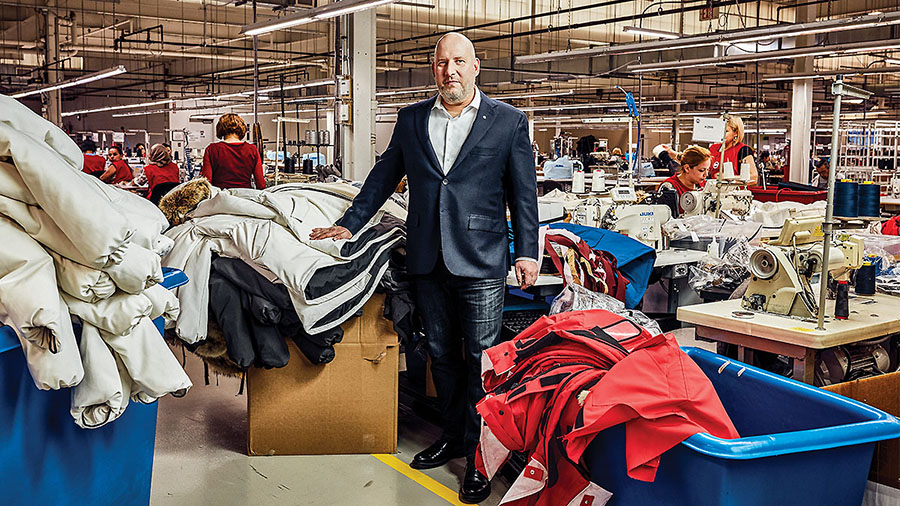Canada Goose Holdings Inc. saw full-year revenues increase 15.4 percent, or up 15.9 percent currency-neutral, to CN$958.1 million in the fiscal 2020 year ended March 29, 2020, compared to CN$830.5 million in the prior fiscal year period. Net income for the fiscal year rose 5.6 percent to CN$151.7 million, or CN$1.36 per diluted share, compared to CN$143.6 million, or CN$1.28 per diluted share, in fiscal 2019.
“Given the underlying circumstances, I am incredibly proud of the results our team has delivered. We are actively and strategically managing through this temporary period of global uncertainty and delivering against key priorities for the business,” said Dani Reiss, President & CEO. “I remain incredibly optimistic about Canada Goose’s prospects for the future.”
COVID-19 Financial Measures
Canada Goose has taken substantial measures to reinforce its strong financial flexibility. Anticipated cash expenses and investments in the first quarter of fiscal 2021 have been reduced by approximately CN$90.0 million, including the following measures:
Operating costs:
- Voluntary salary reductions of 20 percent for all Executive Team members, with President & CEO Dani Reiss continuing to forego his entire salary indefinitely
- Lower variable SG&A costs from previously announced temporary closures of retail stores and down-filled jacket manufacturing
- Refocused marketing investments towards brand storytelling and e-commerce
- Abatements of certain retail and manufacturing fixed rent expenses
Working capital:
- Elimination of the large seasonal inventory investments typical at this time of year, due to the mandated suspension of down-filled jacket manufacturing
◦ Strong finished goods position enables the company to meet demand as stores re-open with a staggered and gradual resumption of down-filled jacket production alongside PPE production for frontline workers in Canada - Payment deferrals of certain retail and manufacturing fixed rent expenses
Capital Expenditures:
- Reduced investments in retail and manufacturing expansion
Liquidity:
- The company increased its ability to borrow against the borrowing base of its existing asset-based revolving credit facility by up to CN$50.0m. This enhances financial flexibility while maintaining low leverage and a highly flexible covenant-lite structure. Pro forma as at June 1, 2020, cash-on-hand was CN$119.7 million and undrawn revolving credit facility capacity was CN$239.4 million.
The company remains confident that its cash flow profile and liquidity will be sufficient to address a varied range of COVID-19 scenarios that may occur through fiscal 2021. This factors in ongoing PPE manufacturing, which is expected to be neutral to cash flow on an annual basis.
Fiscal 2020 Details (in Canadian dollars, compared to Fiscal 2019):
- DTC revenue increased to CN$525.0 million from CN$431.3 million, driven by incremental revenue from new retail stores. The channel was severely impacted by political disruptions in Hong Kong and global COVID-19 disruptions in the third and fourth quarters of fiscal 2020, respectively. These matters resulted in lower levels of tourism, retail traffic, and consumer spending, in addition to frequent reductions to regular store operating hours and unplanned store closures, all impacting revenue.
- Wholesale revenue increased to CN$424.0 million from CN$394.7 million, driven by incremental revenue contributed by Baffin, higher pricing, and higher-order values from international distributors. As COVID-19 disruptions to partner operations intensified through the fourth quarter, there was a significant reduction to shipments, impacting revenue.
- Other segment revenue increased to CN$9.1 million from CN$4.5 million.
- Gross profit was CN$593.3 million, a gross margin of 61.9 percent, compared to CN$516.8 million and 62.2 percent, respectively. The slight decrease in gross margin was attributable to lower wholesale gross margin, partially offset by favorable channel mix, with a higher proportion of DTC revenue.
- DTC gross profit was CN$395.0 million, a gross margin of 75.2 percent, compared to CN$324.6 million and 75.3 percent, respectively. The change in gross margin (-10 bps) was driven by higher costs (-130 bps), including both input costs and incremental costs from the expansion of in-house manufacturing capacity. This was partially offset by a higher volume of parka sales of (+100 bps).
- Wholesale gross profit was CN$197.8 million, a gross margin of 46.7 percent, compared to CN$192.5 million and 48.8 percent, respectively. The change in gross margin (-210 bps) was driven by higher costs (-220 bps), including both input costs and incremental costs from the expansion of in-house manufacturing capacity and unfavorable product mix reflecting the growth of lower margin non-parka sales (-180 bps). This was partially offset by higher pricing (+130 bps).
- Other segment gross profit was CN$0.5 million, a gross margin of 5.5 percent, compared to CN$(0.3) million and 6.7 percent. This includes CN$1.2 million of overhead costs resulting from the temporary closure of manufacturing facilities.
- Operating income was CN$192.1 million, an operating margin of 20.1 percent, compared to CN$196.7 million and 23.7 percent, respectively. The decrease in operating income and operating margin was driven by lower DTC and wholesale operating margins and higher corporate expenses.
- DTC operating income was CN$249.0 million, an operating margin of 47.4 percent, compared to CN$223.3 million and 51.8 percent, respectively. Pre-store opening and temporary closure costs of CN$8.2 million and CN$1.7 million, respectively, were incurred in the current fiscal year. Excluding pre-store opening and temporary closure costs, DTC operating margin was 49.3 percent in fiscal 2020 compared to 52.1 percent in fiscal 2019. This decline reflects reduced revenue due to COVID-19 impacts on fixed cost leverage and profitability across the channel, and lower profitability levels for current year store openings.
- Wholesale operating income was CN$145.1 million, an operating margin of 34.2 percent, compared to CN$151.1 million and 38.3 percent, respectively. The decrease in operating margin reflects the gross margin decline described above, together with increases in warranty costs of CN$3.8 million, higher headcount costs of CN$2.3 million, and other fixed costs. COVID-19 revenue impacts in the fourth quarter negatively affected fixed cost leverage and profitability across the channel.
- Other segment operating loss was CN$202.0 million, compared to CN$177.7 million. This includes unallocated corporate expenses, which rose to CN$193.2 million from CN$169.1 million, resulting from increased investment in marketing of CN$13.8 million and higher foreign exchange losses of CN$9.6 million.
- Adjusted EBIT was CN$207.4 million, compared to CN$206.9 million.
- Adjusted net income was CN$147.2 million, or CN$1.32 per diluted share, compared to adjusted net income of CN$151.6 million, or CN$1.36 per diluted share.
Outlook
The negative financial impacts of COVID-19 will be more pronounced in the first quarter ending June 28, 2020, with a negligible level of revenue expected. The first quarter is historically the smallest in the fiscal year, representing 7.4 percent of annual sales in fiscal 2020.
Throughout the first seven weeks of the first quarter of fiscal 2021, GOOS said 75 percent or 15 of 20 retail stores in the DTC channel were temporarily closed. 2 of the 5 stores that were open during this period, both in Hong Kong, have been severely impacted by restrictions on inbound tourism. The store in Paris re-opened on May 20, followed by Milan on May 29 and Montreal on June 2. Further openings are being evaluated on a staged region-by-region basis, based on regulatory guidelines and supporting traffic trends as well as the health and safety of employees and guests.
While e-commerce is operational in all markets and digital engagement is strong, this off-season period is a low point for consumer purchasing online. In the wholesale channel, shipments to retailers have been largely shut off since March due to disruptions from retail store closures.
Given prevailing global uncertainties, including the evolution of ongoing outbreaks, the duration of retail store closures, the pace of retail normalization following re-openings and the impact of economic developments and travel restrictions on consumer discretionary spending, all of which are unknown, the company is not providing an outlook for fiscal 2021.
Photo courtesy Dani Reese, President & CEO, Canada Goose














